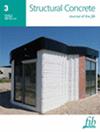使用基于输入能量的损伤预测模型和自定心指数对自定心摇动墩进行损伤评估
IF 3.3
3区 工程技术
Q2 CONSTRUCTION & BUILDING TECHNOLOGY
引用次数: 0
摘要
严重地震发生后,桥梁能否立即发挥作用对于不间断的救援行动至关重要。关于桥梁韧性的重要性,在过去几十年中,已经开发出了残余位移小、损坏程度小的后张法(PT)摇动桥墩。桥墩两端的摇晃机制可避免弯矩和过度的挠曲破坏。这种系统的自定心(SC)能力是通过后张力提供的。为了达到最佳抗震设计和改造目的,必须预测 PT 摇摆系统在地震灾害后的实际震损程度和自定心能力。在这种情况下,我们提出了一种自定心指数(SI),用于评估桥墩在承受循环荷载和地震荷载时的自定心能力。该 SI 与可行的损坏预测模型配合使用时,可预测桥墩在循环或地震荷载情况下是否仍可修复。基于输入能量的损伤指数(IEB-DI)考虑了累积滞后能量,在比较了许多基于能量的损伤指数后,根据循环加载试验下观察到的损伤情况对 IEB-DI 进行了校准。该损毁指数被选为最合适的损毁预测模型,并被认为可在时间历程分析后简单应用。在本研究中,使用上述破坏极限状态和引入的 SI 评估了抗震双系统的抗震性能,该系统由三个 RC 弯道和一个 SC 弯道组成。将作为参考模型的整体桥梁的破坏预测与双桥的估计破坏进行了比较。结果表明,联合应用 IEB-DI 和拟议的 SI 预测 SC 摇动桥墩的性能水平,可以得到一个全面的损坏预测模型。本文章由计算机程序翻译,如有差异,请以英文原文为准。
Damage assessment of self‐centering rocking piers using an input energy‐based damage prediction model coupled with self‐centering index
The immediate functionality of bridges following severe earthquakes is vital for uninterrupted rescue operations. Regarding the significance of resiliency in bridges, post‐tensioned (PT) rocking piers with low residual displacements and minimal damages have developed over the past few decades. The rocking mechanism at two ends of the pier avoids bending moments and excessive flexural damage. The self‐centering (SC) capacity in this system is provided through post‐tensioning forces. Concerning optimum seismic design and retrofit purposes, it is essential to predict the actual degree of seismic damage and SC capacity of PT rocking systems after seismic hazards. In this case, a self‐centering index (SI) is proposed to evaluate the SC capacity when piers are subjected to cyclic and seismic loadings. This SI, when used in co‐operation with a viable damage prediction model, predicts whether or not the piers remain reparable under cyclic or seismic loading scenarios. After comparing a number of energy‐based damage indices, all of which consider the cumulative hysteresis energy, with the input energy‐based damage index (IEB‐DI), the latter was calibrated against observed damages under cyclic loading tests. This DI was chosen as the most suitable damage prediction model and was considered to be simply applicable after time history analysis. In this study, the seismic performance of a seismic‐resistant dual system, consisting of three RC bents along with an SC bent, was evaluated using the aforementioned damage limit states and the introduced SI. The damage predictions of the monolithic bridge, as the reference model, were compared with the estimated damage to the dual bridge. The results show that the joint application of the IEB‐DI and the proposed SI in predicting the performance level of SC rocking piers results in a comprehensive damage prediction model.
求助全文
通过发布文献求助,成功后即可免费获取论文全文。
去求助
来源期刊

Structural Concrete
CONSTRUCTION & BUILDING TECHNOLOGY-ENGINEERING, CIVIL
CiteScore
5.60
自引率
15.60%
发文量
284
审稿时长
3 months
期刊介绍:
Structural Concrete, the official journal of the fib, provides conceptual and procedural guidance in the field of concrete construction, and features peer-reviewed papers, keynote research and industry news covering all aspects of the design, construction, performance in service and demolition of concrete structures.
Main topics:
design, construction, performance in service, conservation (assessment, maintenance, strengthening) and demolition of concrete structures
research about the behaviour of concrete structures
development of design methods
fib Model Code
sustainability of concrete structures.
 求助内容:
求助内容: 应助结果提醒方式:
应助结果提醒方式:


